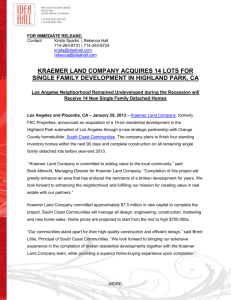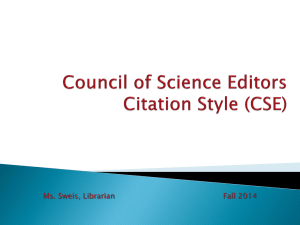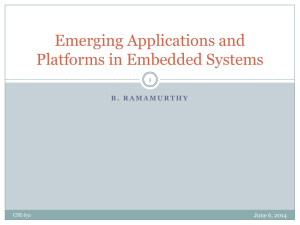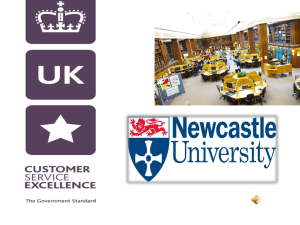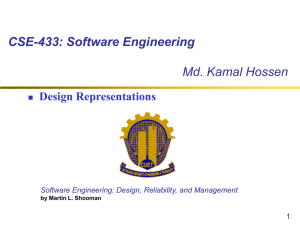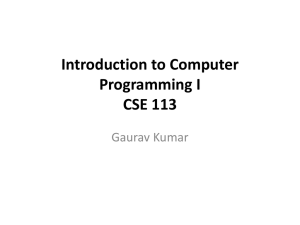State Modeling
advertisement
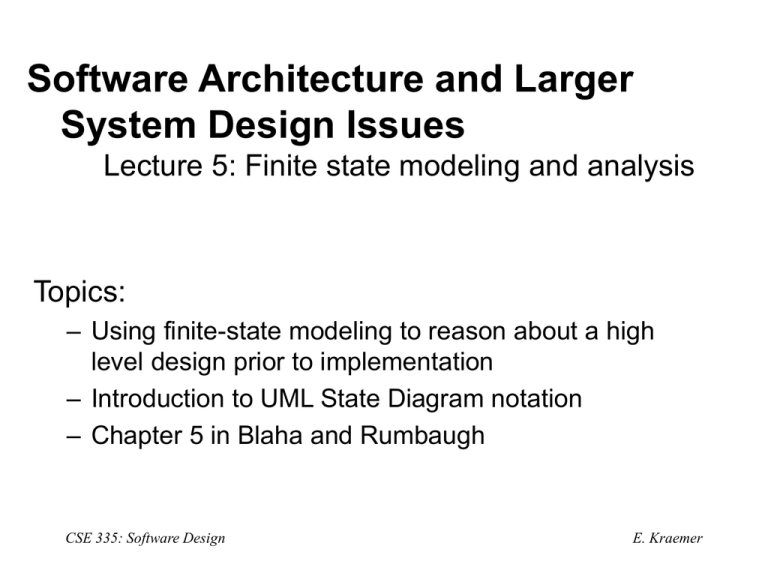
Software Architecture and Larger System Design Issues Lecture 5: Finite state modeling and analysis Topics: – Using finite-state modeling to reason about a high level design prior to implementation – Introduction to UML State Diagram notation – Chapter 5 in Blaha and Rumbaugh CSE 335: Software Design E. Kraemer Motivation and overview Some objects in a system have complex temporal behaviors, which must be carefully designed – E.g., modern interactive and distributed applications • Typically comprise multiple active objects • Use locking primitives to synchronize threads – E.g., embedded systems where software controls devices • Devices run “in parallel” with controller • Communicate with one another by signalling Design problems: – e.g., race conditions and synchronization anomalies – e.g., lost or unexpected signals, deadlock Issue: How to design to prevent these problems CSE 335: Software Design E. Kraemer Concrete example Shift-lock actuator Remote interface Software controller Starter interface CSE 335: Software Design to engine from engine E. Kraemer Potential problems in such systems Controller enters a state in which it is no longer receptive to signals from its environment – Signals may arrive but have no effect – Controller may prevent issuing of signals • e.g., greying out of buttons in a graphical dialog box Controller enters a state in which it is receptive to some signals, but not those that are being offered by the environment Controller expects some peer to be in a state that is ready to receive a signal, sends the signal, but the peer isn’t ready CSE 335: Software Design E. Kraemer Problems (continued) The bad news: Most of these problems cannot be reliably detected and fixed via testing – Some are “race conditions” • Depend on how the various actors are scheduled by OS • Difficult to reproduce • Instrumentation (for diagnosis) may make them go away! – Very difficult to simulate all possible interactions with an environment • Often we test our programs under lots of assumptions about how they will be used • These assumptions often turn out to be naive CSE 335: Software Design E. Kraemer Current state of the practice... Relies on “designing out” these problems rather than trying to uncover and reproduce them after the fact Aided by finite state modeling and analysis of software architectures – Model each entity in the system as a communicating finite state machine – Simulate interactions between state machines, looking for flaws Model checking: Attempts to exhaustively analyze a system specified in this fashion CSE 335: Software Design E. Kraemer Finite-state models Describe temporal/behavioral view of a system Specify control: – Sequence operations in response to stimuli – Distinguish states, events, and transitions – Especially useful during design Lots of variants: – E.g., StateCharts, UML state diagrams – E.g., FSP (textual notation) CSE 335: Software Design E. Kraemer Key terms Event: occurrence at a point in time – instantaneous – often corresponds to verb in past tense • e.g., alarm set, powered on – or onset of a condition • e.g., paper tray becomes empty, temperature drops below freezing State: behavioral condition that persists in time – often corresponds to verbs with suffix of “-ing” • e.g., Boiling, Waiting, Dialing – in OO terms: an abstraction of values of attributes and configuration of objects Transition: instantaneous change in state – triggered by an event CSE 335: Software Design E. Kraemer State diagrams Graphical state-modeling notation: – States: labeled roundtangles – Transitions: directed arcs, labeled by triggering event, guard condition, and/or effects Specifies the response of an object to input events - ignores events except those for which behavior is prescribed Example: S T States CSE 335: Software Design E. Kraemer State diagrams Graphical state-modeling notation: – States: labeled roundtangles – Transitions: directed arcs, labeled by triggering event, guard condition, and/or effects Specifies the response of an object to input events - ignores events except those for which behavior is prescribed Example: Transition S T States CSE 335: Software Design E. Kraemer State diagrams Graphical state-modeling notation: – States: labeled roundtangles – Transitions: directed arcs, labeled by triggering event, guard condition, and/or effects Example: Event Transition event(attribs) [condition] / effect S T States CSE 335: Software Design E. Kraemer Enabling and firing of transitions Transition is: – enabled when source state is active and guard condition satisfied – fires when enabled and the triggering event occurs Example below: – enabled when current state is Editing and the form is complete – fires when the user presses the “OK” button Editing pressOK [form complete] CSE 335: Software Design Submitted E. Kraemer Enabling and firing of transitions Transition is: – enabled when source state is active and guard condition satisfied – fires when enabled and the triggering event occurs Example below: – enabled when current state is Editing and the form is complete – fires when the user presses the “OK” button Editing pressOK [form complete] Submitted Question: What happens if user presses “OK” when transition not enabled? CSE 335: Software Design E. Kraemer guard condition • boolean expression that must be true for transition to occur • checked only once, at time event occurs; transition fires if true CSE 335: Software Design E. Kraemer “One-shot” state diagrams • represent objects with finite lives – have initial and finite states • initial state - entered on object creation • final state - entry implies destruction of object CSE 335: Software Design E. Kraemer Example Chess game start state White’s turn black moves stalemate white moves stalemate Black’s turn CSE 335: Software Design checkmate checkmate Default final state E. Kraemer Example Chess game start state White’s turn black moves checkmate Draw stalemate checkmate CSE 335: Software Design Final states stalemate white moves Black’s turn Black wins White wins E. Kraemer Example - entry and exit points Chess game White’s turn black moves white moves Black’s turn CSE 335: Software Design checkmate stalemate Black wins Draw stalemate White wins checkmate E. Kraemer Phone Line example • construct on board CSE 335: Software Design E. Kraemer Events Event : occurrence at a point in time Concurrent events : causally unrelated; have no effect on one another CSE 335: Software Design E. Kraemer Kinds of events Signal event: – the sending or receiving of a signal • an explicit one-way transmission of information • may be parameterized – E.g., stringEntered(“Foo”) – Sending of a signal by one object is a distinct event from its reception by another CSE 335: Software Design E. Kraemer Signal class - UML notation keyword “signal” in << >> << signal >> Flight Departure airline flightNum city date CSE 335: Software Design name of signal class attributes E. Kraemer Kinds of Events • Change event – caused by satisfaction of a boolean expression – Intent: Expression continually tested; when changes from false to true, the event happens – Notation: when(val1 < val2) • Time event – caused by the occurrence of an absolute time or the elapse of a time interval – when (time = some_time) – when (date = some_date_ – after (n time_units) CSE 335: Software Design E. Kraemer State Diagrams • graph whose nodes are states and whose directed arcs are transitions between states • specifies state sequences caused by event sequences • all objects in a class execute the state diagram for that class; diagram models their common behavior – Note: state names are unique w/in scope of state diagram CSE 335: Software Design E. Kraemer State Model • multiple state diagrams, one for each class with important temporal behavior – diagrams interact by passing events and through side effects of guard conditions – events and guard conditions must match across diagrams in the model CSE 335: Software Design E. Kraemer Details – if more than one transition leaves a state, then the first event to occur causes the corresponding transition to fire – if an event occurs and no transition matches it, the event is ignored – if more than one transition matches an event, only one transition will fire but the choice is nondeterministic CSE 335: Software Design E. Kraemer Effect • effect = a behavior executed in response to an event – can be attached to a transition or a state – listed after a “/” – multiple effects separated with a “,” and are performed concurrently CSE 335: Software Design E. Kraemer Activity Effects • Activity = behavior that can be invoked by any number of effects • May be performed upon: – a transition – entry to or exit from a state – some event within a state • Notation: – event / resulting-activity CSE 335: Software Design E. Kraemer Activities Often useful to specify an activity that is performed within a given state – E.g., while in PaperJam state, the warning light should be flashing – E.g., on entry into the Opening state, the motor should be switched on – E.g., upon exit of the Opening state, the motor should be switched off CSE 335: Software Design E. Kraemer Activity effects r_button_down / showPopup Idle Menu visible r_button_up / hidePopup CSE 335: Software Design E. Kraemer Do-Activities • continue for an extended time • can occur only within a state • can not be attached to a transition • may be performed for all or part of time object is in state • may be interrupted by event received during execution; event may or may not cause state transition PaperJam do/ flash warning light CSE 335: Software Design E. Kraemer Entry and Exit Activities • can bind activities to entry to/ exit from a state Opening entry / motor up exit / motor off CSE 335: Software Design E. Kraemer Alternative reps … CSE 335: Software Design E. Kraemer Order of activities 1. activities on incoming transition 2. entry activities 3. do-activities 4. exit activities 5. activities on outgoing transition CSE 335: Software Design E. Kraemer Completion Transition • triggered by completion of activity in the source state State 1 do / blah() CSE 335: Software Design State 2 E. Kraemer Potential problem … [ x > 20] State 3 [ x < 10] State 4 State 1 do /blah() if (x ==12) when blah() completes?? CSE 335: Software Design E. Kraemer Problems with FSMs Difficult to read with lots of states and transitions Two sources: – Multiple transitions with same triggering event, guard condition, and response but different source and/or target states – State explosion due to concurrency and/or orthogonality Ameliorated somewhat by modularity features: – State generalization – Parallel composition CSE 335: Software Design E. Kraemer Example: Automatic transmission Transmission pushR pushF Neutral Reverse pushN pushN pushN upshift upshift First pushN Second downshift CSE 335: Software Design Third downshift E. Kraemer Problem: Multiple similar transitions Transmission pushR pushF Neutral Reverse pushN pushN pushN upshift upshift First pushN Second downshift CSE 335: Software Design Third downshift E. Kraemer Solution: State generalization Transmission pushR Neutral Reverse pushF pushN pushN Forward upshift upshift First Second downshift CSE 335: Software Design Third downshift E. Kraemer State generalization Introduces an abstract “super state”: – decomposes into multiple sub-states – when super state is active, exactly one of its substates is active Outbound transition incident on super-state abbreviates set of transitions, one from each sub-state Inbound transition incident on super-state enters sub-state that is distinguished as the start state CSE 335: Software Design E. Kraemer Example: Lifecycle of a thread Thread Runnable Ready yield dispatch Created start suspend Running stop stop CSE 335: Software Design Blocked resume end Terminated stop E. Kraemer Problem: Composite behaviors Consider an automobile with multiple options: – – – – Automatic transmission Temperature control (heating/air) Rear-window defroster Stereo system Suppose we wish to construct a state diagram for the autmobile: – Assume car starts with transmission in neutral and temp control, rear defroster, and stereo are all off – What are the possible next states? CSE 335: Software Design E. Kraemer Example: Automobile states HeatOn_Neutral_DefOff_RadOff AirOn_Neutral_DefOff_RadOff Started pushR TCOff_Reverse_DefOff_RadOff TCOff_First_DefOff_RadOff ... CSE 335: Software Design E. Kraemer State explosion problem Number of states in a composite diagram is product of the number of states in component diagrams Major impediment to understanding: – Impossible to visualize in any meaningful way – Requires the use of analysis tools to verify properties Managing state explosion: – Concurrent state diagrams – Highly effective when diagram can be separated into truly orthogonal components CSE 335: Software Design E. Kraemer Example Automobile Temperature control TempOn pushAir Cooling TempOff pushTCOff pushHeat Rear defroster pushHeat pushAir Heating Radio control pushRD RDOff pushRad RDOn pushRD CSE 335: Software Design RadOff RadOn pushRad E. Kraemer Semantics of parallel composition Multiple interpretations: – Concurrent regions execute independently • What happens if transitions in different regions are triggered by same event? • Do both execute simultaneously? Does one “consume” the event to the exclusion of the other? – Concurrent regions communicate with one another, synchronizing on common events • Regions can only proceed when all are ready to proceed • Regions transfer data values during a concurrent transition – Do we distinguish internal and external events? CSE 335: Software Design E. Kraemer

